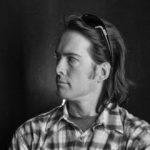Lincoln Phillips
During a life-altering trip to the Far East, high school junior Lincoln Phillips contracted two strange infections. One was an unidentifiable (but fortunately short-lived) bug picked up in a disused hotel swimming pool where the teens had been cautioned not to swim in the first place. The other was the photo bug, which found an ideal host in Lincoln and still thrives in his system today.
Lincoln was in his junior year when he and his fellow ‘Student Ambassadors’ went on a whirlwind, six-week tour of Japan, China, Hong Kong and Taiwan. ‘Taking a bunch of goofy high school kids abroad was kind of a recipe for disaster,’ he says. ‘I guess we had some very brave and admirable chaperones because we all returned unscathed. For me, the trip was amazing, a real eye-opener. I wasn’t as aware of the world as I should have been but I began to realize that photography was how I could express myself and capture my experience. I still have the boxes of those slides, and recently I’ve been mining back through them to find some common threads in my travel work.’
Heredity and environment combined to make Lincoln susceptible to the photo bug. His older brother had built a darkroom in the family basement, and Lincoln followed his sibling’s footsteps not only into the darkroom and but also into a popular photography program at the Denver high school both attended. ‘It was independent of the usual yearbook program. For lack of a better phrase, you could call it an art photography course,’ he says. ‘The teacher, Jim Bloomfield, was really great. I ended up being his assistant in my senior year.’
Lincoln believes that he got his visual gene from his mother who sketched, painted and worked in ceramics. ‘She is an amazing artist, a very visual person,’ he says. ‘When I was young, she would hold holiday arts & crafts boutiques with her artist buddies. I remember vividly having all these strangers come into the house to look at all these crazy things my mom and her friends had made. It was quite fun growing up.’
Receiving his first name from a mysterious photo in the family album may have given Lincoln still another push in the visual direction. ‘When I was little, I would ask where my name came from. My mother would show me this photo, and all I could see was a dense green tropical forest. You had to look very closely to see two figures, my great uncle Lincoln and his wife, sitting in a tree house. They were on vacation somewhere in South America. It wasn’t much to go on for a little person trying to figure out who he was named after, but it did leave a lot to the imagination’
‘The prospect of wearing a suit for the next 50 years was kind of daunting’
Despite the artistic influences, Lincoln entered college thinking about a traditional career. His father worked in the financial industry, seemed to enjoy it thoroughly, and thought that Lincoln should at least keep his professional options open. ‘Going off to college, my main thought was, Oh, my god. Now I have to choose something I’m going to do for the rest of my life. The prospect of wearing a suit for the next 50 years was kind of daunting but photography wasn’t exactly encouraged as a major in those days.’
Lincoln took both fine art and economics courses during his first year at Arizona State University. Transferring to the University of Colorado in Denver, he began to find some ‘wonderful mentors in the photography program who really helped me hone in and realize that this was something I could make a career in.’ With moral support from both parents, he earned a BFA, then went on to complete the MFA program in Photography at the University of Iowa. By that time, he had realized that what he really wanted to do was photograph and teach.
Lincoln is now Professor of Photography and Chair of Visual Arts at the Community College of Denver. He has also taught at the University of Colorado, the Metropolitan State College of Denver, and the University of Iowa. His fine art images have been exhibited in many group, solo and juried shows. Travel continues to be an important theme in his work but not in the traditional sense. ‘I’m not just interested in the visual aspect of a site,’ he says. ‘I also want to document my emotional and psychological state while traveling. The work kind of bleeds over into travel photography but in a more personal vein.’ Lincoln has continued his travel and photography experience with trips to Europe, Britain, Peru, and the Near East. When not abroad, he frequently photographs in national parks and the wilderness areas of the Southwest.
Specializing in travel documentary work, including images from Southern Italy, Indonesia, and two Fulbright-Hays seminars abroad: Syria & turkey in 2007, and most recently to Morocco in 2015. ‘The region of Syria is the wellspring of most of the major religious movements of our time,’ he says. ‘It’s a very rich place, not only in terms of history and museums, but also in terms of having living, breathing, thriving communities of all major religions, as well as more obscure sects including Zoroaster.’
Throughout the first half of his travel documentary career, Lincoln made his personal work on film with a medium format camera. But on his trips to Southern Italy, Indonesia and Morocco, he shot exclusively in full-frame digital (Nikon D3 & D3s) ‘Having digital at your disposal means capturing more images in different ways. The image quality and color depth captured by digital cameras has of course advanced enormously, allowing you to create striking images with ease. With additional choices in capture comes the added flexibility for creative approaches to your work.
Lincoln has taught photography on many levels over the years and still finds that his creative energies get charged up in the classroom. He especially enjoys working with beginners in small groups. ‘That’s where I can give the students the biggest payoff,’ he says. ‘Teaching is a two-way kind of experience. It’s really nice to see people making discoveries about themselves and the process. It also feeds my energy for the medium and helps me stay in the groove. The small group setting of the Digital Photo Academy gives me the chance to address each person’s concerns, regardless of experience, within the framework of the course.’
Call Digital Photo Academy at 1 877 372 2231. Lots of people seem to hang up if our welcome recording comes on instead of a live voice, but we promise to return your message within a day or two if you leave one with your name and number. It would be even better if you included your e mail address as well as the date and city of the class you are considering. If leaving a voice mail message is not your thing, please email us at DPAbooking@digitalphotoacademy.com or Richard@digitalphotoacademy.com.
[pix_slideshow data_slideshow=’lincoln-phillips’]


